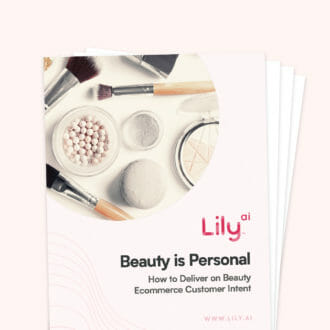Giving Beauty a Boost: Part 2
It’s been established that today’s consumer is knowledgeable, sophisticated, and tends to know exactly what they want or need in a beauty product. In part one of this two-part blog series, we discussed how small details drive beautiful results and showed how retailers can thrive in today’s beauty landscape by focusing on site search, personalization, and SEO/SEM.
In part two, we’re going to focus on the key areas of text-driven search, item set-up and demand forecasting, and showcase how Lily AI can boost the consumer experience and revenues for those currently lacking beauty product attribution in the industry.
Boost Your Text-Driven Search Capabilities
Today, retailers can drive powerful recommendations for their users based on better text search capabilities. With the right text-driven data, beauty brands can build a strong beauty product attribution library of instantly shoppable taxonomies.
Although we tend to shop based on what we see, there is room for focusing on text when it comes to beauty e-commerce. Based on the shopper’s personal preferences, Lily AI’s beauty taxonomy is able to provide synonyms that will enhance a retailer’s product recommendations. For example, “lip gloss” can also be known as lip glaze, lip topper, liquid gloss, and tinted gloss.
There are many alternative ways an attribute can be named, but with optimized text search capabilities, a consumer’s search for “lip topper” will still return “lip shine” products if part of the same taxonomy.
Modern text algorithms can extract detailed information about a product’s style, how customers are using or wearing it, and what they like and dislike about it. That data is raw material for delivering more relevant and better personalized recommendations and search results.

Boost Your Item Set-Up
The root cause of product data problems usually starts here, with generic, out-of-the-box attributes – rather than customer-driven attributes – taking the wheel. But we’ve got the solution to fix it. Lily AI helps retailers build strong product taxonomies with highly accurate, text-driven beauty product attribution data. When product attribution is done correctly, it instantly unlocks better site search, filters and facets, product recommendations, and demand forecasting.
Thin and inconsistent product details start during item set-up, and have cascading effects down the line. Lily AI’s universal language of customer-centered attributes removes extensive manual work and lets AI do the heavy lifting.
We enable merchandising teams to work smarter, so they can spend their time on other things. Lily AI powers rapid product onboarding and eliminates days of manual work, while setting merchandisers up with a customer-centered product taxonomy that will drive better decision-making for years.
Boost Your Demand Forecasting
It’s not about what a consumer has bought before, but more so why they bought it. If a beauty retailer is ordering products based only on history and with minimal attributes, the ability to forecast demand adequately and sustainably greatly diminishes. Inconsistent product details also lead to data that can’t be used effectively to forecast demand.
With Lily, beauty retailers can increase full-margin sales by making informed, customer-centric predictions about what shoppers are likely to buy in coming months and accurately forecast demand for brand-new product lines. Brands can then increase full-price sell-through and improve forecast accuracy by up to 25%. The team at Lily even taps into their extensive expertise to advise our retailing partners on core trends and upcoming market shifts.
The more insight retailers have into a customer’s preferences, the better positioned they are to anticipate demand, sell at full margins, and eliminate the uncertainty that causes overstocking. By forecasting demand using a language that’s focused on customer-driven attributes – not legacy attributes – retailers can increase their ability to sell customers what they’re looking for right now and decrease the need to mark that inventory down later.
Lily helps to replace wholesale pre-orders with a leaner, demand-led, made-to-order model that fuels product development with AI to launch lines that are guaranteed to sell out quickly. In retail, granular product attributes can help reduce mountains of unsold inventory in the warehouse, and Lily AI helps retailers reduce assortment complexity, clean up the product catalog, and use data analytics to identify the most profitable Stock Keeping Units (SKUs).
Lily 101
From search, to personalization, to demand forecasting, Lily AI supercharges the entire e-commerce stack with customer intent.
Lily AI comes equipped with the deepest image recognition platform built for retail e-commerce with two million plus new data points being added on a daily basis. One million products and counting have received manual labeling by industry experts and one billion plus training data points have been collected thus far.
There is a prime focus on accuracy of data, detailed and strict guardrails of attribute definitions, and self-training or self-learning capabilities from underlying AI models to power an exponential rate of advancement. Overall, Lily has a 95% industry-leading accuracy and is trusted by global retailers and industry leaders.
Thrive in Today’s Beauty Industry with Lily AI

